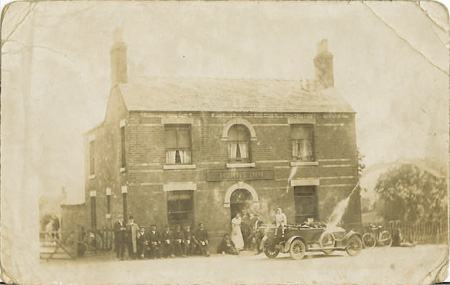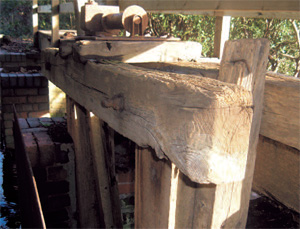Making nails for Staffordshire
This small village once played a vital role in the local iron
industry. Its name derives from the rolling and slitting mills
that dominated it during the 17th and 18th centuries.

After the decline of the iron industry Slitting Mill became a local beauty spot. Visitors would come to
see the waterfall, or to gather around Rising Brook for a picnic or a paddle. In winter, people skated on
Horns Pool, repairing to the nearby Horns Inn for refreshments
A slitting mill specialises in the production of nails. After
iron bars had been flattened (or ‘rolled’) they were ‘slit’ into rods. In 1623 Thomas Chetwynd was operating a
highly successful mill here, one of the first of its kind in
the Midlands. Between 1692 and 1710 it handled most of
the output of the Staffordshire ironworks.
What’s in a name? Stonehouse or Slitting Mill?
This village used to be known as Stonehouse. The
name came from the large building that stands on
the junction of Slitting Mill Road and Penkridge Bank
Road. At the end of the 19th century, the name of
the village was changed to Slitting Mill.

The oldest parts of The Stonehouse date from the late 16th or
early 17th century. Its name is derived from the large blocks of
dressed stone known as ‘ashlar’ that were used in its construction.
Until the beginning of the 19th century, the Stonehouse remained
the property of the Weston family, who built it. In 1807, Sarah
Hopkins, a local philanthropist, moved in.
During the Second World War, The Stonehouse became the base
for the Air Ministry’s Number 20 Works Area. By 1957, it had
become their No 6 Works Area Headquarters.
A local benefactor
Sarah Hopkins, who lived in The Stonehouse and
founded almshouses in Rugeley, was also a great local
benefactor. She funded schools in Rugeley, Brereton,
and here in Slitting Mill, where Stonehouse Infant
School opened in 1830. Upon her death in 1844 Sarah
Hopkins left £600 to provide £15 per year for a
schoolmistress to teach children aged 2 to 10 years of
age. By 1896, after a Mixed National School was built
in the village, Stonehouse Infant School had closed, but
her legacy was transferred to the new school.

Horns Inn c1920-21. When this postcard was written, the landlord
was probably Mr Simmonds. His
daughter, Lil, was known locally
as the pianist who provided live music for the silent movies at the
Palace Cinema in Rugeley
|
St John the Baptist Church
How often do you see a semidetachedchurch attached to a
modern house?
This church, which was opened as a
mission chapel in 1871, was originally
built onto Stonehouse Infant School.
Religious services had been held in the
school in the absence of a church, so it
made sense to build the church right
next to it. The original school building
was eventually demolished and a
modern house was built on the site
around 1970.

St John’s Church

|
After the arrival of the rolling and
slitting mills, a tin-plating mill was
established in the village. In around
1810 Horns Pool (also known as
Dutton’s Pool) was created to hold
the water that drove the mill.
Sluice gates controlled the flow of
water into the pool, enabling it to
fill up. When the mill was ready to
run, the water was released and
cascaded down an 18 foot drop
(nearly three metres), powering the
mill machinery. The water then
rejoined Rising Brook.
You can find sluice gates and the
waterfall at the end of Horns Pool.

A sluice at Horns Pool
|

Bridge at Horns Pool

Waterfall at Horns Pool
Images courtesy of Paul Shires
|








